Figures & data
Figure 1. HA-specific serum IgG (A) and IgA (B) responses in mice in the immunogenicity study. Groups of 6 mice were immunized twice (21 day interval) intranasally with plant derived H1N1 vaccine at 15, 5 or 1.5 μg HA in combination with 5 μg of c-di-GMP or with PBS plus 5 μg cdi-GMP (control). Blood samples were collected at days 0, 21, 28, 35 and 42 and serum IgG and IgA levels were analyzed by ELISA. * = significantly (P < 0.05) different from Day 0 titers.
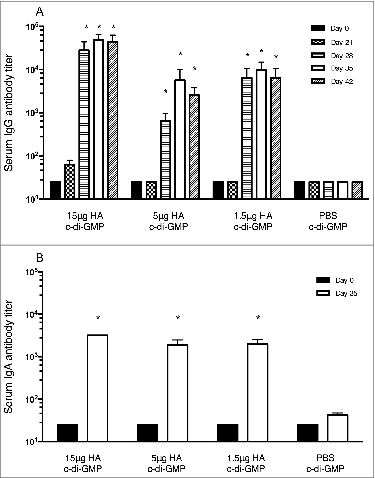
Figure 2. Serum HI antibody response in mice before challenge with the A/Indonesia/05/2005 (H5N1) virus. Groups of 16 mice were immunized twice (21 day interval) intranasally with plant derived vaccine at 15, 5 or 1.5 μg HA in combination with 5 μg of c-di-GMP or with PBS plus 5 μg cdi-GMP (control). Blood samples were collected pre-vaccination (Day −1) and at 20, 32, and 41 days post vaccination. The data show HI responses of each individual mouse and the horizontal lines represent geometric mean titers ± 95% confidence interval. The dotted line represents an HI titer of 40.
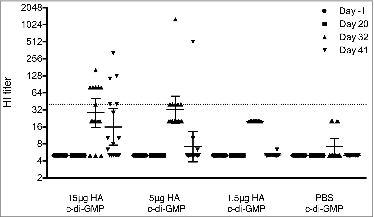
Figure 3. Virus titers in the upper (nasal turbinates, A) and lower (lungs, B) respiratory tract after challenge with the A/Indonesia/05/2005 (H5N1) virus. Groups of 16 mice were immunized twice (21 day interval) intranasally with plant derived vaccine at 15, 5 or 1.5 μg HA in combination with 5 μg c-di-GMP or with 5 μg c-di-GMP/PBS (control). Mice were challenged by intranasal administration of highly pathogenic avian Influenza A/Indonesia/05/2005 (H5N1) on day 42. Groups of 3 mice were euthanized at days 3 (Day 45) and 5 (Day 47) post-challenge to examine for the presence of virus in the upper (nasal turbinates, A) and lower (lungs, B) respiratory tract. The limit of detection was 102.5 TCID50/mL for nasal turbinates and 101.5 TCID50/mL for lung tissue.
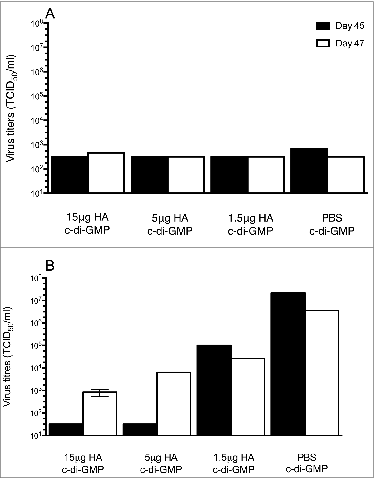
Figure 4. Changes in body weight (A) and mortality (B) of vaccinated mice after the A/Indonesia/05/2005 (H5N1) virus challenge. Groups of 16 mice were immunized twice (21 day interval) intranasally with the adjuvanted vaccine at a HA content of 15, 5 or 1.5 μg or with 5 μg c-di-GMP/PBS (control). Mice were challenged by intranasal administration of highly pathogenic avian Influenza A/Indonesia/05/2005 (H5N1) on day 42. (A); Body weights were obtained daily for 2 weeks post-challenge (days 0-14). The weight of the animals as measured on the day of viral challenge (day 0) was used as the baseline weight to determine changes in body weight post viral challenge. (B); The survival rate (percentage) of mice was examined daily for 2 weeks post virus challenge.
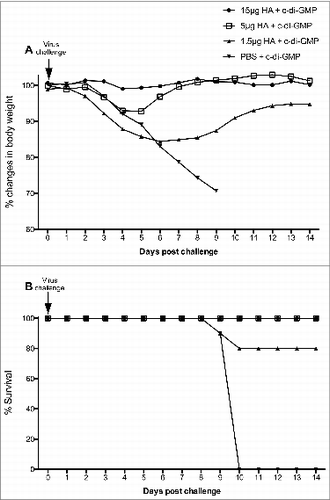
Figure 5. Virus recovery from the respiratory tract and systemic organs of vaccinated ferrets after challenge with A/Indonesia/05/2005 (H5N1) virus. Ferrets were vaccinated with 2 doses of the plant-derived vaccine (45 μg HA) adjuvanted with c-di-GMP (50 μg), non-adjuvanted vaccine or PBS (control) 14 days apart by the intranasal route. The ferrets were then challenged at 14 days after the second vaccine dose with the A/Indonesia/05/2005 (H5N1) live virus by the intranasal route. On day 3 post-challenge, 5 ferrets from each group were sacrificed and lung, nasal turbinate (NT), brain, olfactory bulb, spleen and nasal wash samples were collected. Tissue samples were homogenized and the clarified homogenates and nasal washes were assayed for the presence of A/Indonesia/05/2005 virus by titration on MDCK cells.
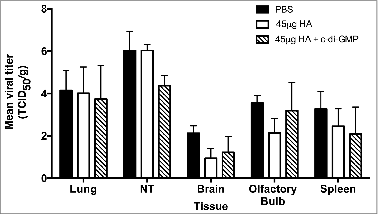
Table 1. Survival rates, temperature rise and weight loss in vaccinated and control ferrets after the A/Indonesia/05/2005 (H5N1) virus challenge. Ferrets were vaccinated with 2 doses of c-di-GMP adjuvanted plant-derived vaccine, vaccine alone and PBS (control) 14 days apart by the intranasal route. The ferrets were then challenged 14 days after the second vaccine dose with the A/Indonesia/05/2005 (H5N1) live virus by the intranasal route. On day 14 post-challenge, the surviving animals were exsanguinated under terminal anesthesia
Figure 6. Percentage weight loss (A) and changes in body temperature (B) in vaccinated and control ferrets following challenge with the A/Indonesia/05/2005 (H5N1) virus. Ferrets were vaccinated with 2 doses of 50 μg c-di-GMP adjuvanted vaccine (45 μg HA + c-di-GMP), vaccine alone (45 μg HA) and PBS (control) 14 days apart by the intranasal route. The ferrets were then challenged 14 days after the second vaccine dose with the A/Indonesia/05/2005 (H5N1) live virus by the intranasal route. Ferrets were monitored daily for 14 days following viral challenge for body weight and temperature.

